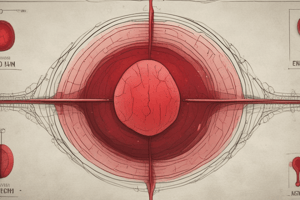Podcast
Questions and Answers
Which term describes the existence of several different versions of a single genetic locus within a population?
Which term describes the existence of several different versions of a single genetic locus within a population?
- Phenotype
- Codominance
- Polymorphism (correct)
- Inheritance
In blood type genetics, how many main alleles exist at each relevant loci?
In blood type genetics, how many main alleles exist at each relevant loci?
- 3 (correct)
- 2
- 4
- 5
What is the term used to describe a situation where both alleles contribute to the observed phenotype simultaneously?
What is the term used to describe a situation where both alleles contribute to the observed phenotype simultaneously?
- Recessiveness
- Codominance (correct)
- Incomplete dominance
- Dominance
Which of the following blood types demonstrates codominance?
Which of the following blood types demonstrates codominance?
How many alleles does each person have at each ABO blood type genetic location?
How many alleles does each person have at each ABO blood type genetic location?
What determines whether a person has a positive or negative Rh blood type?
What determines whether a person has a positive or negative Rh blood type?
In the context of blood type genetics, what are the possible combinations for the ABO blood group system?
In the context of blood type genetics, what are the possible combinations for the ABO blood group system?
Which blood group system best illustrates incomplete dominance?
Which blood group system best illustrates incomplete dominance?
What can happen if a person with the Rh factor transfuses blood to an individual without the Rh factor?
What can happen if a person with the Rh factor transfuses blood to an individual without the Rh factor?
Which alleles determine whether an individual is Rh-positive or Rh-negative?
Which alleles determine whether an individual is Rh-positive or Rh-negative?
Flashcards are hidden until you start studying
Study Notes
Non-Mendelian Genetics Traits of Blood
In the realm of human inheritance, blood type genes serve as a fascinating example of non-Mendelian genetics. Unlike the more familiar Mendelian patterns where individual genes are directly inherited from parents, these blood-type-related traits exhibit complex interactions between different gene variants. This article will explore some key aspects of this topic, including multiple alleles, codominance, the Rh factor, incomplete dominance, and blood types.
Multiple Alleles
Blood type genes demonstrate what is known as polymorphism—the existence of several different versions of a single genetic locus within a population. These variations are called alleles, and they can differ in terms of their phenotypic effects. In the case of ABO blood type genetics, there are three main alleles at each of the two relevant loci (A, B, and O), with additional rarer ones like AB and H also existing. Each person has two alleles at each of these locations, one inherited from each parent.
Codominance
Unlike many other Mendelian traits, which follow recessive or dominant patterns, blood type genes often show codominance. This means that both alleles contribute to the observed phenotype simultaneously, resulting in heterozygotes having characteristics intermediate between those of homozygous individuals. For instance, someone who is AO would have a mixed blood type, likely appearing redder than someone with pure O blood but still lacking any features of A blood such as anti-B antibodies.
Rh Factor
The Rhesus (Rh) blood group system, a distinct set of blood groups determined by another set of alleles, further complicates the picture. The presence or absence of an antigen called D on the surface of red blood cells determines whether a person has a positive or negative Rh blood type. The Rh factor is a glycoprotein present on the red blood cell membrane that can cause immune reactions if transfused into people without it, leading to antibody production and potentially severe complications.
Incomplete Dominance
While most blood type alleles display two well-defined phenotypes, there are cases where incomplete dominance occurs. This phenomenon is best illustrated by the Kell blood group system. Here, individuals may express a combination of A and B antigens even when heterozygous for only one of them. As a result, individuals with a K blood type might still produce antibodies against blood types they don't carry the corresponding gene for.
Blood Types
Understanding how blood types are inherited requires understanding their underlying genetic basis. For example, the ABO blood group consists of four possible combinations of A and B alleles. Individuals can be AA, BB, AB, or OO, which determine their specific blood type. Similarly, the Rh system involves D and d alleles, with individuals being either positive or negative, depending on whether they carry the D antigen.
In summary, the study of blood type genetics provides an interesting glimpse into complex, non-Mendelian patterns of inheritance. From the interaction of multiple alleles to the nuances of codominance, the Rh factor, incomplete dominance, and various blood types, these systems offer valuable insights into the intricate dance of our genetic makeup and its expression.
Studying That Suits You
Use AI to generate personalized quizzes and flashcards to suit your learning preferences.



